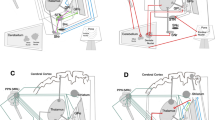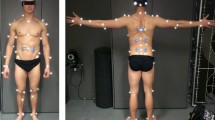Abstract
Phobic postural vertigo is characterized by subjective imbalance and dizziness while standing or walking, despite normal values for clinical balance tests. Patients with phobic postural vertigo exhibit an increased high-frequency sway in posturographic tests. Their postural sway, however, becomes similar to the sway of healthy subjects during difficult balance tasks. Posturographic recordings of 30 s of quiet stance was compared to recordings of 30 s of quiet stance during a postural threat, which consisted of the knowledge of forthcoming vibratory calf muscle stimulation, in 37 consecutive patients with phobic postural vertigo and 24 healthy subjects. During quiet stance without the threat of forthcoming vibratory stimulation, patients with phobic postural vertigo exhibited a postural sway containing significantly more high-frequency sway than the healthy subjects. During the quiet stance with forthcoming vibratory stimulation, i.e., anticipation of a postural threat, the significant differences between groups disappeared for all variables except sagittal high-frequency sway. During postural threat, healthy subjects seemed to adopt a postural strategy that was similar to that exhibited by phobic postural vertigo patients. The lack of additional effects facing a postural threat among phobic postural vertigo patients may be due to an already maximized postural adaptation. Deviant postural reactions among patients with phobic postural vertigo may be considered as an avoidant postural response due to a constant fear of losing postural control.
Similar content being viewed by others
References
Andersson G, Yardley L, Luxon L (1998) A dual-task study of interference between mental activity and control of balance. Am J Otol 19:632–637
Barlow DH (2001) Clinical handbook of psychology. Guilford Press, New York
Brandt T (1996) Phobic postural vertigo. Neurology 46:1515–1519
Carpenter MG, Frank JS, Silcher CP, Peysar GW (2001) The influence of postural threat on the control of upright stance. Exp Brain Res 138:210–218. doi:10.1007/s002210100681
Fransson PA, Tjernstrom F, Hafstrom A, Magnusson M, Johansson R (2002) Analysis of short- and long-term effects of adaptation in human postural control. Biol Cybern 86:355–365. doi:10.1007/s00422-001-0305-y
Fransson PA, Hafstrom A, Karlberg M, Magnusson M, Tjader A, Johansson R (2003) Postural control adaptation during galvanic vestibular and vibratory proprioceptive stimulation. IEEE Trans Biomed Eng 50:1310–1319. doi:10.1109/TBME.2003.819851
Holmberg J, Karlberg M, Fransson PA, Magnusson M (2003) Phobic postural vertigo: body sway during vibratory proprioceptive stimulation. Neuroreport 14:1007–1011. doi:10.1097/00001756-200305230-00020
Holmberg J, Karlberg M, Harlacher U, Rivano-Fischer M, Magnusson M (2006) Treatment of phobic postural vertigo: a controlled study of cognitive-behavioral therapy and self-controlled desensitization. J Neurol 253:500–506. doi:10.1007/s00415-005-0050-6
Johansson H, Sojka P (1991) Pathophysiological mechanisms involved in genesis and spread of muscular tension in occupational muscle pain and in chronic musculoskeletal pain syndromes: a hypothesis. Med Hypotheses 35:196–203. doi:10.1016/0306-9877(91)90233-O
Kapfhammer HP, Mayer C, Hock U, Huppert D, Dieterich M, Brandt T (1997) Course of illness in phobic postural vertigo. Acta Neurol Scand 95:23–28. doi:10.1111/j.1600-0404.1997.tb00063.x
Kolb FP, Lachauer S, Maschke M, Timmann D (2002) Classical conditioning of postural reflexes. Pflugers Arch 445:224–237. doi:10.1007/s00424-002-0892-z
Krafczyk S, Schlamp V, Dieterich M, Haberhauer P, Brandt T (1999) Increased body sway at 3.5–8 Hz in patients with phobic postural vertigo. Neurosci Lett 259:149–152. doi:10.1016/S0304-3940(98)00917-3
Ledin T, Fransson PA, Magnusson M (2004) Effects of postural disturbances with fatigued triceps surae muscles or with 20% additional body weight. Gait Posture 19:184–193. doi:10.1016/S0966-6362(03)00061-4
Maki BE, McIlroy WE (1996) Influence of arousal and attention on the control of postural sway. J Vestib Res 6:53–59. doi:10.1016/0957-4271(95)00014-3
Querner V, Krafczyk S, Dieterich M, Brandt T (2000) Patients with somatoform phobic postural vertigo: the more difficult the balance task, the better the balance performance. Neurosci Lett 285:21–24. doi:10.1016/S0304-3940(00)01008-9
Riley MA, Stoffregen TA, Grocki MJ, Turvey MT (1999) Postural stabilization for the control of touching. Hum Mov Sci 18:795–817. doi:10.1016/S0167-9457(99)00041-X
Shea CH, Wulf G (1999) Enhancing motor learning through external-focus instructions and feedback. Hum Mov Sci 18:553–571. doi:10.1016/S0167-9457(99)00031-7
Acknowledgments
This study was supported by grants from The Swedish Research Council (2004-4656) and the Council for Medical Health Care in South Sweden.
Author information
Authors and Affiliations
Corresponding author
Rights and permissions
About this article
Cite this article
Holmberg, J., Tjernström, F., Karlberg, M. et al. Reduced postural differences between phobic postural vertigo patients and healthy subjects during a postural threat. J Neurol 256, 1258–1262 (2009). https://doi.org/10.1007/s00415-009-5110-x
Received:
Accepted:
Published:
Issue Date:
DOI: https://doi.org/10.1007/s00415-009-5110-x




